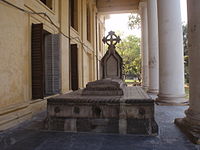Charlotte Canning, Countess Canning





Charlotte Canning, Countess Canning (31 March 1817 – 18 November 1861[1]), one of the most prolific women artists in India, was the wife of Charles Canning, 1st Earl Canning. Two portfolios in the Victoria and Albert Museum in London contain some three hundred and fifty watercolours by her, the result of four major tours in India.[2]
She was born Charlotte Stuart in Paris, a daughter of the British ambassador, Charles Stuart (later Baron Stuart de Rothesay) and was a Lady of the Bedchamber to Queen Victoria from 1842 to 1855. On 5 September 1835, she married Hon. Charles Canning a son of the ex-British Prime Minister, George Canning and the 1st Viscountess Canning. In 1837 Charles succeeded to his mother's title as Viscount Canning, whereupon Charlotte became Viscountess Canning.
Lady Canning arrived in India in 1856 as a flourishing, healthy woman when her husband was appointed Governor-General of India. She went with him to Calcutta and described her situation as being 'isolated to a degree I could never have imagined'. She kept a journal and wrote frequently to Queen Victoria, at one point describing 'strange and terrible outbreaks' of violence which were the start of the 'Indian Mutiny'. In 1859 Charles was raised in the peerage as Earl Canning and Charlotte became Countess Canning.
The Countess began to look emaciated in 1861 and she died of malaria in her husband's arms. She was buried in Barrackpore, West Bengal. Lord Canning did not long outlive her; his letter to Victoria describing her death crossed with the Queen's to him, announcing that Prince Albert had died. Lady Canning's name lives on in Bengal where a type of sweet called ledikeni is named after her. Her grave and memorial seems to have been moved some time since 2005 and is now located adjacent to St John's Church in Calcutta.
Bibliography
- The story of two noble lives : being memorials of Charlotte, Countess Canning, and Louisa, Marchioness of Waterford (Volume 1) - Hare, Augustus John Cuthbert, 1834-1903
- A Glimpse of the Burning Plain: Leaves from the Indian Journals of Charlotte Canning - Charles Allen (Michael Joseph (October 1987)) ISBN 978-0-7181-2667-4
- Below the Peacock Fan: First Ladies of the Raj - Marian Fowler
References
- ^ Appletons' annual cyclopaedia and register of important events of the year: 1862. New York: D. Appleton & Company. 1863. p. 208.
- ^ EXTRACTS FROM THE BOOK "INDIAN LIFE AND LANDSCAPES BY WESTERN ARTISTS" - Chapter Six: The Role Of Amateur Artists
